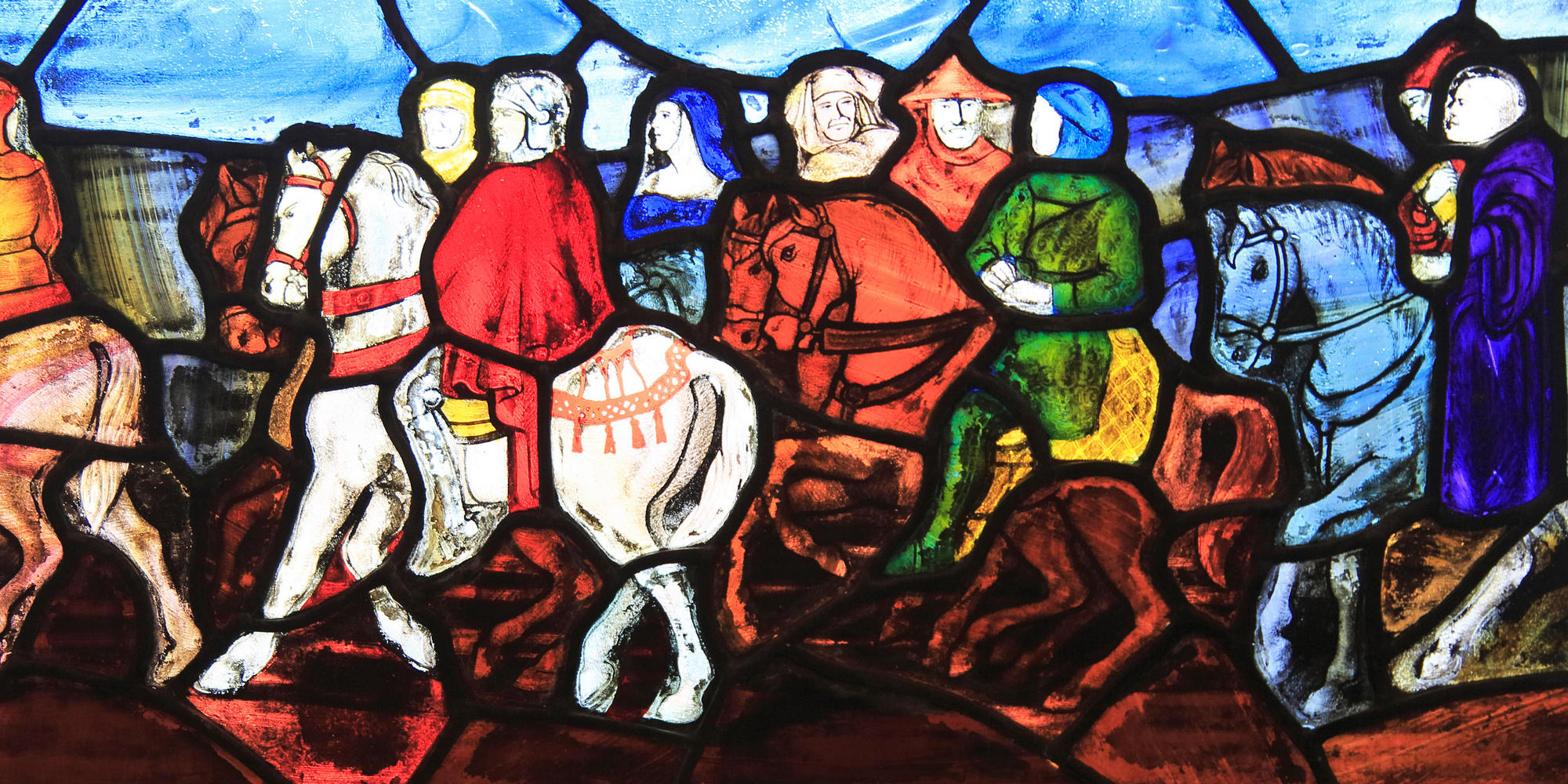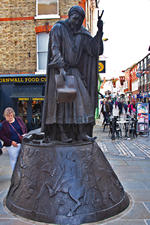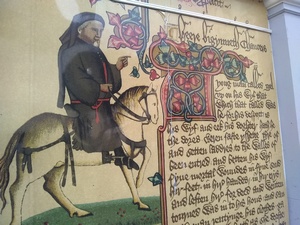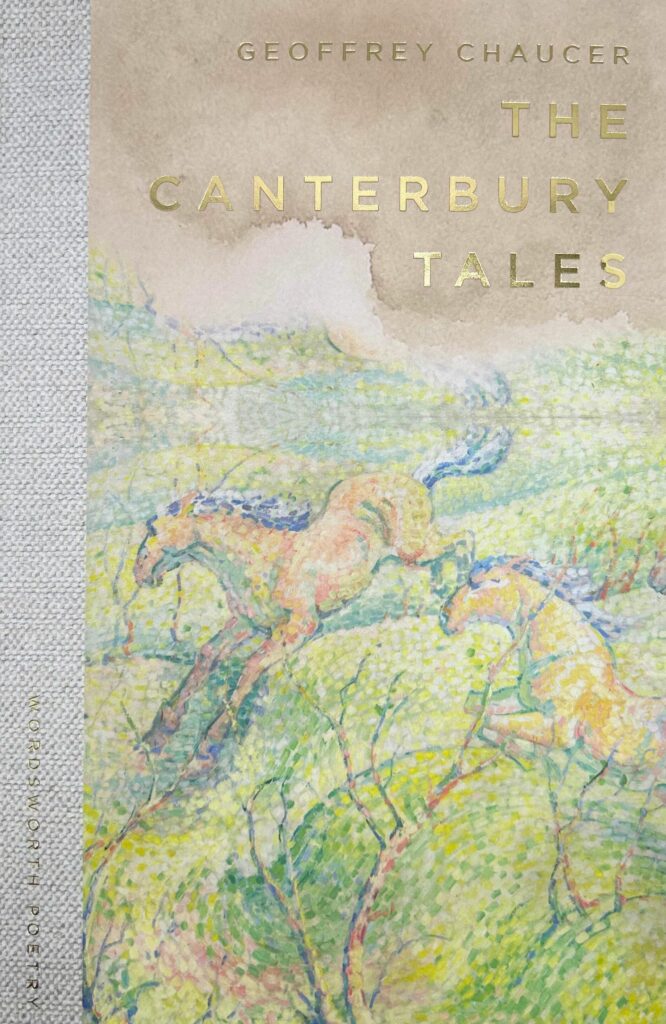
Sally Minogue looks at The Canterbury Tales
On National Poetry Day, Sally Minogue salutes the father of English poetry, Geoffrey Chaucer, and his seminal work, ‘The Canterbury Tales’.
There’s a newish (2016) statue of Geoffrey Chaucer in the middle of Canterbury, a rather belated tribute by this city that has benefitted hugely both from the early pilgrimages to Thomas Becket’s shrine and the enduring popularity of the eponymous Canterbury Tales. I might as well make my view plain, that the statue is in the worst tradition of public sculpture, that of faux-authenticity, where a prior age is envisioned uncritically through the filter of a twenty-first-century imagination. The Canterbury Commemoration Society, which sponsored the project, has form in this respect, with the 2006 statues of the 6th century Kentish King Ethelbert and Queen Bertha, prancing towards each other in their flowing bronze robes across a bit of green sward, like lovers reunited at the end of a Hollywood romcom.
 But I stray. Whatever my personal distaste for its aesthetics, the statue of Chaucer does at least recognise the centrality in our culture of this founding father of English poetry. It is fitting likewise that it is placed in a city at the heart of Christianity – as evidenced in the pilgrimage Chaucer depicts. But stop there if you think that this is a work expressive of a monolithic ethic and ideology, let alone a religious work. The clue is in the plural, Canterbury Tales. Chaucer had a prior Anglo-Saxon oral tradition of storytelling to draw on, but equally evident is a similarity in narrative organisation and structure to Boccaccio’s The Decameron (c.1348-1353), with its set up of a group of young people isolated together from the plague, telling multiple stories to pass the time. See: https://wordsworth-editions.com/blog/decameron It is the multiplicity in both texts that is significant. Like Boccaccio’s, Chaucer’s tales range from the erotic through to the philosophical, encompass broad comedy and pathos, and by the simple device of using different voices they eschew authorial commitment. As readers/listeners we can move through these various stories almost as the pilgrims moved through the landscape. There is constant mobility, and with that comes openness and empathy. Judgement is eschewed, as there is no one dominant voice. The reader is left to take in this panoply of stories, told in the individual voices of the pilgrims. We make of them what we will.
But I stray. Whatever my personal distaste for its aesthetics, the statue of Chaucer does at least recognise the centrality in our culture of this founding father of English poetry. It is fitting likewise that it is placed in a city at the heart of Christianity – as evidenced in the pilgrimage Chaucer depicts. But stop there if you think that this is a work expressive of a monolithic ethic and ideology, let alone a religious work. The clue is in the plural, Canterbury Tales. Chaucer had a prior Anglo-Saxon oral tradition of storytelling to draw on, but equally evident is a similarity in narrative organisation and structure to Boccaccio’s The Decameron (c.1348-1353), with its set up of a group of young people isolated together from the plague, telling multiple stories to pass the time. See: https://wordsworth-editions.com/blog/decameron It is the multiplicity in both texts that is significant. Like Boccaccio’s, Chaucer’s tales range from the erotic through to the philosophical, encompass broad comedy and pathos, and by the simple device of using different voices they eschew authorial commitment. As readers/listeners we can move through these various stories almost as the pilgrims moved through the landscape. There is constant mobility, and with that comes openness and empathy. Judgement is eschewed, as there is no one dominant voice. The reader is left to take in this panoply of stories, told in the individual voices of the pilgrims. We make of them what we will.
Chaucer’s tales are linked to their various tellers, and it follows that the General Prologue is key to our enjoyment. Here he introduces us to all the characters on the pilgrimage, including himself. For the author is himself a pilgrim, a character in his own story; so we need to be careful to distinguish the voice of the character/narrator from that of the overarching author, ‘Chaucer’. The Prologue is in some ways the liveliest part of the work, and the part that might be most familiar to a modern reader. Chaucer positively enjoys himself, painting sharp, sometimes malicious, pen-portraits of his imagined fellow-pilgrims. If there is a judgemental voice in the poem, it comes here, in the author’s monolithic, omniscient description of his fellow-travellers. There are ‘nyne and twenty in a company Of sondry folk’, plus the author himself. These characters are ‘by aventure y-falle In felaschipe’ (Prologue, ll. 24-6). Think a modern coach tour, or perhaps a cruise, but with mixed ages and backgrounds. Of course what binds this company is ‘pilgrimage’ – a serious religious intent, to worship at the shrine of St Thomas Becket, murdered some 200 years earlier. Maybe a trip to Lourdes would be nearer to it.
There’s no doubt, though, that this would also have been something like a holiday for the participants. When Chaucer uses the word ‘aventure’ he means ‘by chance’ – it is the simple coincidence of their all being on the same journey that brings them into a loose fellowship. But the word brings to mind also that this is a venture, i.e. a going forth, and ‘aventure’ is the Middle English root of the modern ‘adventure’, a new experience involving something of the unknown, with the excitements, even dangers, that brings. As the narrator tells us of the Wife of Bath:
Sche was a worthy woman al hire lyfe;
Housbondes ate chirche dore hadde sche fyfe …
And thries hadde sche ben at Jerusalem.
(Prologue, ll. 459-463)
 Going on pilgrimage doesn’t impede the getting of husbands; and maybe the Wife of Bath is after her sixth. The narrator is clear-sighted, and this is part of the fun of the Prologue. Gradually we understand that those who are meant to be emblems of religious goodness are quite the opposite. In comparison the potentially warm embrace of the gap-toothed (indicating sexually free) Wife of Bath seems good-hearted and good-humoured. The most critical observation is reserved for those who assist in the Church’s operations. The Monk, the Friar, the Summoner and the Pardoner are all shown to have scant regard for the religious principles they exploit. The real butt of Chaucer’s satire here is the Church itself, but he has some nice thrusts at the hypocrisy of the servants of the Church, who do not forebear from gluttony and lust, whilst extracting payment or confession for those same sins from others who hold their religion in high regard. This is a theme that will be further highlighted in the Tales. At the same time, whilst we can infer the author’s anti-clerical attitude, the diversity of approach and of voices means that this is never a didactic work. We find the critiques within the spaces of the text, some of them made by dislocations between the teller and the tale, some of them via the mismatch between the General Prologue and the personal prologue that some of the pilgrims voice as they introduce their tales.
Going on pilgrimage doesn’t impede the getting of husbands; and maybe the Wife of Bath is after her sixth. The narrator is clear-sighted, and this is part of the fun of the Prologue. Gradually we understand that those who are meant to be emblems of religious goodness are quite the opposite. In comparison the potentially warm embrace of the gap-toothed (indicating sexually free) Wife of Bath seems good-hearted and good-humoured. The most critical observation is reserved for those who assist in the Church’s operations. The Monk, the Friar, the Summoner and the Pardoner are all shown to have scant regard for the religious principles they exploit. The real butt of Chaucer’s satire here is the Church itself, but he has some nice thrusts at the hypocrisy of the servants of the Church, who do not forebear from gluttony and lust, whilst extracting payment or confession for those same sins from others who hold their religion in high regard. This is a theme that will be further highlighted in the Tales. At the same time, whilst we can infer the author’s anti-clerical attitude, the diversity of approach and of voices means that this is never a didactic work. We find the critiques within the spaces of the text, some of them made by dislocations between the teller and the tale, some of them via the mismatch between the General Prologue and the personal prologue that some of the pilgrims voice as they introduce their tales.
So to the Tales themselves. In a series that takes in all manner of men and women, high and low, and their stories, Chaucer begins in a proper fashion – a conventional fashion – with the Knight’s Tale, just as he had begun the Prologue with that ‘verray parfit, gentil knight’ (Prologue, l. 72). Our author is here recognising a particular tradition of chivalry, familiar to the modern reader from the legends of King Arthur and the Round Table. The Knight’s Tale embodies all the virtues of courtly love, and though the two knights Palamon and Arcite are placed in opposition by their love of Emily, the workings of the tale mean that both loves are recognised. Similarly, the two men are in some part reconciled, as the fatally injured Arcite cedes his prize, Emily, to Palamon. Here the modern reader might properly object that Emily is no more than a cipher, the impossibly distant object of love to both men. But the tale can be understood in terms of its place in a particular cultural and poetic tradition, one symbolic of the power of love.
It’s useful to approach these Tales historically; they were, after all written over 600 years ago. Yet what springs always from Chaucer’s pages is a common humanity which he celebrates even as he shows us its flaws. If the ‘parfit’ Knight takes precedence in tale-telling, he is followed immediately afterwards by the brazenly imperfect Miller. The Miller has been described to us in the Prologue in broad terms: ‘Full big he was of braun and eek of boones’. Other distinguishing features are a wart at the very end of his nose, with a tuft of hairs ‘Reed as the berstles of a souw’s eeres’. (Prologue, ll. 544, 552) Chaucer is here using a standard identification of a man’s physical characteristics with his moral ones: we do not expect refinement from the Miller. And we do not get it! His tale is possibly the best-known bawdy story of the Tales. A carpenter, John, marries a much younger, pretty wife, Alisoun, who is at the same time courted by both John’s apprentice Nicolas, and the parish clerk Absalon. This is a tale that can still make for uncomfortable reading, not because of the open expression of sexuality, but rather because of its debasement. No-one in this tale shows any sort of loving-kindness to their fellow man or woman, love is reduced to brute physical appetite, and if a rise can be got from someone’s weakness, that will be exploited to the full. True, there’s a certain democracy in a story that has Absalom trapped into kissing Alisoun’s ‘naked ers’ (arse), then getting his revenge with a hot poker when presented in turn with Nicholas’s bare bottom. John is punished, it seems, simply for having married a young pretty woman, as she and Nicholas play a nasty joke on him, persuading him that Noah’s flood is coming, so that they can pursue their dalliance. His resulting injury and distress are seen as madness, and he is made mockery of by the townspeople. The only person who gets away with her behaviour is Alison. So in my retelling, this is a rather unpleasant little story showing the most brutish side of humanity.
But it’s no accident that it’s placed directly after the Knight’s Tale, Chaucer using the narrative expedient of the Miller’s drunkenness to allow him to cut in on the Monk who was due to be next (a writerly device disguised as a nice little nod to realism). Lust is the central element of the Miller’s tale, crude in its expression as the love of Palamon and Arcite in the previous tale is high-flown. But really they are both sides of the same story. The Knight’s Tale shows us love through the prism of a highly unrealistic code of courtly values; the Miller’s Tale shows us bodily love as it is reduced to simple appetite in the harsh demands of day-to-day living in the 14th century. Between the two ends of the spectrum lie all gradations of human life and relationship, as we shall see in the ensuing tales.
 These are too many to enumerate, and the pleasure of a long varied poem like this is that the reader may pick and choose. The work doesn’t have to be read from start to finish – indeed there are competing views about the ways in which the Tales are ordered (since no definitive manuscript of the whole survives). The work can be seen as a set of short stories, linked by the pilgrimage context, and varied by the diversity of the tellers. To take one of the tales as an example, one could read the General Prologue’s account of the Pardoner (Prologue, ll. 663-708), then the Pardoner’s own Prologue, and then his tale, and consider the complex picture this triumvirate can weave. The authorial description emphasises the Pardoner’s feminine characteristics – long yellow hair worn uncovered and flowing over his shoulders, no beard, a light voice – and summarises ‘I trowe he were a gelding or a mare’. Whereas in some of his portraits, Chaucer links physical characteristics with moral ones, there seems to be no such analogy here. Perhaps our poet was simply interested in representing as wide a cross-section of humankind as possible, as he is when setting the fastidious Prioress against the life-loving Wife of Bath. At any rate, he seems almost to admire the artistry of the Pardoner in extracting money from those who believe his pigs’ bones to be saints’ relics, or his old pillowcase to be the veil of the Virgin Mary herself:
These are too many to enumerate, and the pleasure of a long varied poem like this is that the reader may pick and choose. The work doesn’t have to be read from start to finish – indeed there are competing views about the ways in which the Tales are ordered (since no definitive manuscript of the whole survives). The work can be seen as a set of short stories, linked by the pilgrimage context, and varied by the diversity of the tellers. To take one of the tales as an example, one could read the General Prologue’s account of the Pardoner (Prologue, ll. 663-708), then the Pardoner’s own Prologue, and then his tale, and consider the complex picture this triumvirate can weave. The authorial description emphasises the Pardoner’s feminine characteristics – long yellow hair worn uncovered and flowing over his shoulders, no beard, a light voice – and summarises ‘I trowe he were a gelding or a mare’. Whereas in some of his portraits, Chaucer links physical characteristics with moral ones, there seems to be no such analogy here. Perhaps our poet was simply interested in representing as wide a cross-section of humankind as possible, as he is when setting the fastidious Prioress against the life-loving Wife of Bath. At any rate, he seems almost to admire the artistry of the Pardoner in extracting money from those who believe his pigs’ bones to be saints’ relics, or his old pillowcase to be the veil of the Virgin Mary herself:
And thus with feyned flaterie and japes
He made the parson and the peple his apes.
(Prologue, ll. 699-700)
The Pardoner is after all only doing his job – which is to sell written pardons, issued by the Church, absolving people’s sins in exchange for hard cash. (The modern practice of carbon offsetting comes to mind.) Pardons and indulgences were part of the fabric of the mediaeval Church, which the poet is once again exposing. But when it comes to the Pardoner’s personal Prologue, he recounts his own dishonest methods with such relish, boasting of the emptiness of the documents he peddles, that he is condemned out of his own mouth:
For myn entente is not but for to wynne,
And nothing for correccioun of synne.
I rekke never when they ben y-beryed
Though that here soules gon a-blakeberyed!
(Pardoner’s Prologue, ll. 115-118)
The Pardoner is only out for money, and as far as he is concerned once someone is buried their soul might as well have gone blackberrying. This homely image speaks both of Chaucer’s linguistic imagination and the Pardoner’s absolute lack of conscience. As with many of the choice phrases and images in this work, it is memorable partly because it so graphically calls to mind a common act (even in today’s world), that of going out to pick blackberries; and partly because of the rhyme of ‘y-beryed’ and ‘a-blakeberyed’. Death and life placed on an absolute par – as they are in the Pardoner’s own tale.
For contrary to expectations, his is one of the most moral of the tales, as three wanton young men seek out Death in order to kill him, but through their own greed end up dead by each others’ hands. So it is Death who finds them. This is a characteristic mediaeval fable – Death conquers all, life is but vanity, fate is more powerful than individual agency – and the telling of it is memorable in the best oral tradition. No sooner is the tale done, however, than the Pardoner reverts to his usual ways, trying to turn the moral story to his own account by selling pardons to the very people he has earlier boasted to about the emptiness of his promises. The Host berates him, saying that he wishes he had his testicles in his hands instead of saints’ relics, since then he could cut them off! Here again the earthy language is apt since it expresses the Host’s contempt for the Pardoner’s hypocrisy; only plain terms can make the true situation clear. But a key moment at the end of this tale sees the Knight make the Host and the Pardoner shake hands. This is a world in which quarrels must be mended, and amity maintained.
I have tried to quote directly from the Middle English text, where I feel quotations can be fairly easily understood. In part I want to show by the similarities in vocabulary the origins in Middle English of our own modern language. Strange as the language may look on the page, much of it is recognisably near to the English we still use. Chaucer made a remarkable choice when he wrote The Canterbury Tales in the vernacular, elevating English to the same level as French or Latin. Then in 1476, only 70 years after Chaucer’s death, Caxton’s printing press revolutionised the duplication and distribution of texts. One of his very first productions was a magnificent edition of The Canterbury Tales (1476), followed in 1483 by an illustrated edition, with woodblock prints. [www.britishlibrary.cn] The Canterbury Tales has been in print and in circulation ever since.
To return briefly to that dratted statue. One reason I dislike it is that it depicts Chaucer as a pilgrim. One might say, fair enough – he does after all appear as that in his own poem. But there is no evidence that Chaucer ever went on pilgrimage, let alone to Canterbury. He would have known, of course, the importance of the Becket shrine and the journeys undertaken to it from far and wide. The circumstantial details he gives of the Tabard Inn in Southwark as the meeting and starting point of the journey give us a sense of historical accuracy. This is good writer’s research from a man steeped in London life. But surely the great father of English poetry should be depicted as a writer? It might not matter if there were several public statues of him; but I was astonished to discover that this is the first and only one in England that depicts Chaucer.
To be charitable, our bronze Chaucer does have a piece of (bronze) vellum in his hand, carrying the text of the opening of his capacious poem. And what an opening it is:
Whan that Aprille with his schowres swoote
The droghte of March hath perced to the roote,
And bathed every veyne in such licour
Of which virtue engendred is the flour …
Than longen folk to gon on pilgrimages
(Prologue, ll.1…12)
Chaucer begins not with religion, nor with the pilgrims themselves, but with Nature, in the sweet season of Spring, when the sap is rising, the world is new, plants bathed in showers begin to grow, and they produce not just their own strength and vigour but spiritual inspiration to humanity in general (‘Of which virtue engendered is the flour’). This is a paean to regeneration, to the turning of the seasons towards new life and growth – almost a pagan hymn. As such it has been drawn on in arguably the greatest modernist poem, written over 500 years later, T. S. Eliot’s The Waste Land:
April is the cruellest month, breeding
Lilacs out of the dead land, mixing
Memory and desire, stirring
Dull roots with spring rain.
Eliot’s opening lines match Chaucer’s almost exactly. But it’s interesting to wonder why, with such similar linguistic material, Eliot’s lines are instinct with existential dread, while Chaucer’s are full of the verve of living. At this moment, it is the latter we are most in need of, and to that, I commend you, gentle reader.
The makers of the statues I refer to in the blog are as follows:
Statue of Chaucer: Sam Holland ARBS
The plinth of the statue of Chaucer: Lynn O’Dowd
Statues of Ethelbert and Bertha: Stephen Melton
There is an interesting carved wooden representation of Bertha in St. Martin’s Church, Canterbury, the site of the chapel in which Bertha worshipped. This wooden statue is also contemporary (late 20th century), and was carved by Sister Concordia Scott. Sister Concordia was both a sculptor and a Benedictine nun who joined the Minster Abbey Community in Kent in 1954 and was professed in 1955. She was Prioress of the Minster Abbey Community from 1984 to 1999. Sister Concordia remained a sculptor alongside and as part of her vocation, her work is commissioned regularly by churches and cathedrals nationally and internationally. Sadly, online search engines throw up the later 2006 statue of Bertha rather than that made by Sister Concordia. It is hard to say exactly why her work is more interesting since it is in the same realist tradition. Perhaps it is that the medium is wood, as in very early religious sculptures. Perhaps it is that it must have required some battles for her to continue her art, even though that art grows from her faith. Perhaps it is that there is a synchronicity between her unusual path and the unusual path of Bertha, embracing Christianity whilst her husband remained pagan. At any rate, I urge any visitors to Canterbury to seek out her carving of Bertha.
See: https://commons.wikimedia.org/wiki/File:StBerthaStatue-stMartinChurchCanterbury2.jpg#/media/File:StBerthaStatue-stMartinChurchCanterbury2.jpg
Main Image: Stained glass picture of the Pilgrimage to Canterbury in Ipswich Library, Suffolk. Credit: Geogphotos / Alamy Stock Photo
Above, top: Statue of Geoffrey Chaucer, High Street, Canterbury. Credit: Stillman Rogers / Alamy Stock Photo
Images of artwork from a closed shop in Canterbury, CT merchandise and Chaucer’s footwear courtesy of Sally Minogue
Books associated with this article
